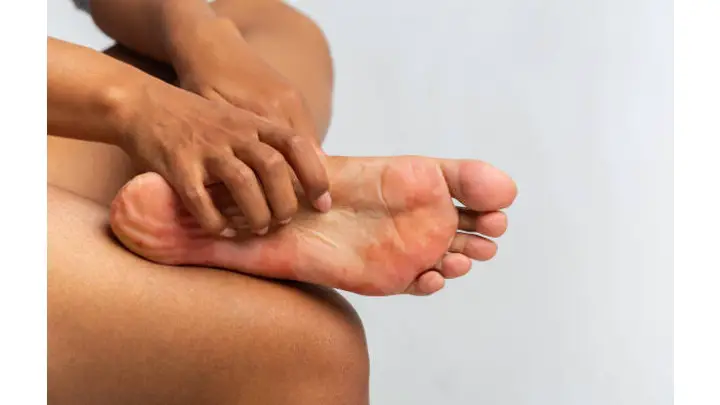Have you ever wondered what causes redness on the bottom of the feet? If so, you should read this article.
In this post, I will explain deeply what causes redness at the bottom of the feet, how to avoid it, and how to treat it.
I will also explain what the redness in your feet means and whether it can be treated quickly. To get more details, keep reading.
SEE: How to Stop Shoes From Rubbing the Back of Your Feet
What does it mean to have redness on the bottom of the feet?
Redness on the bottom of the feet is a sudden or gradual inflammation affecting some parts of the feet. It could be the bone, the skin, the flesh, or cartilage and muscles. The pain can be continuous or gradual, depending on the type and cause of the redness.
However, while redness of the feet can be irritable and discomforting, it is not a cause for intervention. Unless the symptoms persist and you need to see a medical professional, the pain should be gone with simple remedies.
What causes redness on the bottom of the feet?
Redness on the bottom of the feet can be caused by various factors such as injuries, insect bites, irritations, bad posture, shoe tightness, and infections.

1. Infection from bacteria and fungi
Usually, skin redness with or without swelling denotes bacteria or fungi infections. When you have small skin cracks, bacteria and fungi can enter, which can lead to cellulitis or skin inflammation that leads to redness.
2. Raynaud’s diseases
When you have little to no blood flow to the fingers and toes – a result of the blood vessels (arteries) in those areas briefly contracting – you may have Raynaud disease.
When you get this, the skin will briefly turn white, then blue. The affected area frequently turns red as blood flow resumes, then it may also itch, burn, or become numb.
3. Allergies
Exposure to certain substances that cause allergic reactions to the skin can result in red, swollen, and itchy skin on the feet. These allergens include nickel, nickel alloys, poison ivy, poison oak, and poison sumac.
4. Deep vein thrombosis
A blood clot that forms in a deep vein in the body, usually in the thigh or lower leg, is known as a deep vein thrombosis (DVT).
In the affected leg, DVT can also result in swelling, pain, and redness. Obesity, childbirth, cancer, surgery, and a prior history of blood clots are also some of the dangers of developing DVT.
5. Heat
A hot temperature is also one of the significant causes of redness on the bottom of the feet. Foot redness that ranges in intensity from mild to severe can be caused by exposure to extreme heat.
6. Traumatizing factors
Injury to the bones, joints, ligaments, or tendons that make up the foot can also cause the foot to be harmed and turn red.
Symptoms of trauma include redness, swelling, pain, and tenderness in the area of injury. These are all signs of the body’s response to the trauma.
SEE: How to Remove Dead Skin From Feet WithThese Easy Remedies
7. Systemic causes
Some illnesses or diseases have the potential to affect many different body parts, including the feet. The systemic disease arthritis causes joint inflammation, which can make the feet red.
Infectious arthritis is another name for septic arthritis. This is brought on by a bacterial, viral, or fungal infection. Staphylococcus aureus, also known as staph, is the most frequent agent for red feet.
8. Irritation of the skin
After prolonged skin contact, some soaps, creams, beauty products, and other substances can also cause foot irritation and redness.
9. Necrotizing fasciitis
A potentially fatal skin condition called necrotizing fasciitis results from an infectious disease of a wound or other injury.
Therefore, if untreated, the infection may spread to nearby body parts, modifying the tone of the skin and weakening the tissue beneath.
Loss of muscle, tissue, or limbs may result from this, and the infection may severely react to the whole body, including the feet, making them look red.
SEE: Here is How to Relieve Plantar Fascia Pain With These 14 Simple Effective Methods
10. Cold
Severe cold temperatures can have a similar effect on the feet as exposure to extreme heat in terms of causing redness.
11. Runner’s foot (tinea pedis)
A commonly detected infection of the feet or toes is known as an athlete’s foot. When you have this infection, some part of the foot goes red.
Therefore, community pools and warm, moist environments are typical transmission routes for this kind of infection.
SEE: Easy Remedies and Treatment to Help You Relieve Heel Pain
How do you treat redness on the bottom of the feet?
To treat redness, you should be assessed by a healthcare practitioner to get the prognosis and the best course of treatment if it is chronic or especially bothersome.
Before getting examined by a doctor, try warm or cold compresses, analgesics, and drinking lots of water. These are some at-home treatments that can be used if foot redness is caused by irritation, infection, trauma, or injury.
SEE: These Natural and Effective Ways to Cure Dry Feet at Home
How do you prevent redness on the feet?
While many effects of foot redness cannot be avoided, some healthy habits can help reduce the risk of some of them. They include:
- Maintain an active lifestyle and a healthy diet to lower your risk of vascular blockage.
- Avoid irritants and allergens.
- Also, use gentle lotions and soaps.
- Any cuts, bruises, or tears on the foot should be cleaned and dried.
- Stay away from temperatures that are too hot or cold.
FAQs
Will your foot redness spread?
Depending on the root cause.
If left untreated, bacterial or fungal infections that cause foot redness may spread past the original site of infection.
Moreover, as the blockage worsens or if a clot that has formed in the vein gets bigger, foot redness brought on by artery or vein blockage can also spread.
However, foot redness brought on by contact with an allergen or irritant typically only affects the area of skin exposed to the offending substance.
What color should the bottom of your feet be?
Healthy feet should be soft, smooth, and pinkish, indicating good blood circulation. Therefore, you should speak with a podiatrist immediately if this isn’t the case.
SEE: Get A Chance To Win A Pair Of Vans Shoes Worth $85
How do healthy feet look?
The toes of strong, healthy feet splay outward and are wide.
Also, if forced into tight, constrictive shoes for an extended period, they may lose this stable, natural shape and take on a pointed shoe look instead.
What do poor circulation feet look like?
A person with poor circulation may experience symptoms like swollen ankles and feet, discolored or blue and red toes, hair loss on the legs, and thin, dry, or dented skin. Ultimately, poor circulation is always a symptom of another illness or condition.
Conclusion
Redness on the feet is frequently, but not always, a warning sign. Infection may occur if there is redness or red streaks, especially if they are preceded by bloating and a warm sensation.
Furthermore, it might be a symptom of poor circulation or any of the conditions above listed n this article.
Additionally, you should see your doctor as soon as possible if you notice discoloration/redness that doesn’t go away in a week, even after using a compress.
Thanks for reading.
If you have enjoyed reading this article, check out Africana Fashion for more.







